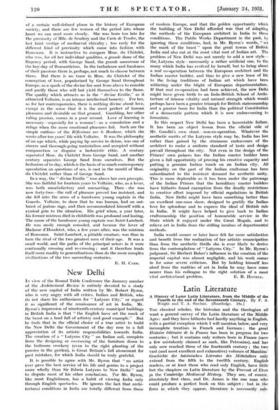New Delhi
view of the Round Table Conference the January number of the Architectural Review is entirely devoted to a study of the new capital of India written by Mr. Robert Byron, who is very angry with all critics, Indian and British, who Jo not share his enthusiasm for "Lutyens City," or regard it as significant of the renaissance of art in India. Mr; Byron's impression of nineteenth-century municipal buildings in British India is that " the English have set the mark of the beast on a land full of artistry and good example.". But he finds that in the official choice of a true artist to build the New Delhi the Government of the day rose to a full appreciation of its artistic responsibilities towards India. The creation of a " Lutyens City " on Indian soil, complete from the designing or overseeing of the furniture down. to the bedroom crockery (even to the right planting of the pansies in the garden), is Great Britain's full atonement for past mistakes, for which India should be truly grateful.
It, is- possible to agree with Mr. Byron that " no artist ever gave the best service of his life and genius to a project more wholly than Sir Edwin Lutyens to New Delhi " and to dispute most of his other conclusions. For Mr, Byron, like most Englishmen, has a habit of viewing India only through English spectacles, lie ignores the fact that archi- tectural conditions in India are ,totally differept from those
of modern Europe, and that the golden opportunity which the building of New Delhi afforded was that of adapting the methods of the European architect in India to those conditions. The Public Works Department in the past, by ignoring these conditions, had, in Mr. Byron's words,. " set the mark of the beast " upon the great towns of British India and also cut at the most vital root of Indian art. The problem of New Delhi was not merely to add a new style— the. Lutyens style—necessarily a rather artificial one, to the many which India has evolved hy herself, but to bring about a real co-operation between the European architect and the Indian master builder, and thus to give a new lease of life to the living traditions of Indian art which have been withering under the blight of European departmentalism. If that real co-operation had been achieved, the new Delhi might have given birth to an Indo-British School of Archi- tecture of intense vitality and natural strength which would perhaps have been a greater triumph for British statesmanship and a greater boon for India than the political Constitution of a democratic pattern which it is now endeavouring_ to formulate.
In this respect New Delhi has been a lamentable failure. It has been an object lesson from the ollicial side of Mr. Gandhi's own stunt—non-co-operation. Whatever the aesthetic merits of the Lutyens style may be, India has lost rather than gained by the strenuous endeavours of the architect to make a uniform standard of taste and design prevail throughout the city. Not even in the design of the Princes' own palaces has the Indian master builder been given a full opportunity of proving his creative capacity and putting a genuine Indian touch on an Indian city. All originality on the part of the Indian craftsman has been subordinated to the insistent demand for aesthetic unity. This is more deplorable as it has been under the patronage of the Indian Princes that the hereditary master builders have hitherto found exemption from the deadly restrictions to creative effort imposed by official regulations in British India. New Delhi might have been something better than an excellent one-man show, designed to gratify the Indian love for splendour and to express the ideal of British rule in India. It might have helped to give back to Indian craftsmanship the position of honourable service in the State which it enjoyed under the Great Moguls, and to relieve art in India from the stifling incubus of departmental methods.
India would sooner or later have felt far more satisfaction and benefit from the realization of her artistic emancipation than from the aesthetic thrills she is ever likely to derive from the contemplation of " Lutyens City." In Mr. Byron's judgment, Sir Herbert Baker's influence in the creation of the imperial capital was almost negligible, and his work comes in for some severe criticism. But by holding himself less aloof from the realities of art in India he may have come nearer than his colleague to the right solution of a most






































 Previous page
Previous page